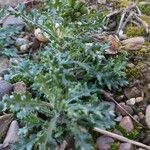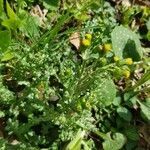Erect, annual herb, 10-50 cm tall. Stems moderate to densely hairy when young, becoming glabrous or sparsely hairy, branched or not from base. Basal and lower cauline lvs sparsely to moderately hairy when young, becoming almost glabrous, petiolate or cuneately narrowed to stem; petiole < lamina, somewhat amplexicaul; lamina irregularly toothed to 1-pinnatifid, elliptic, narrow-obovate to oblong, acute, (1)-2-10 × (0.5)-1-3 cm; venation pinnate; segments ovate or oblong, irregularly dentate. Upper cauline lvs becoming smaller, narrower, apetiolate, and usually amplexicaul and toothed at base. Capitula in small panicles, dense at flowering, loose at fruiting. Supplementary bracts 8-21, lanceolate to triangular, 1-2.5 mm long. Involucral bracts (13)-18-21, linear, glabrous, 5.5-8 mm long. Ray florets 0. Disc dull yellow, 2-3-(4) mm diam. Achenes terete or slightly flattened, densely hairy between ribs, 1.8-2.8 mm long; pappus 4-7 mm long.
Annual 1–4 dm from a ± evident taproot, leafy throughout, sparsely crisp-hairy or subglabrous; lvs coarsely and irregularly toothed to more often pinnatifid, 2–10 × 0.5–4.5 cm, the lower tapering to the petiole or petiolar base, the upper sessile and clasping; heads several or many, discoid, the fls all tubular and perfect; disk 5–10 mm wide; invol 5–8 mm, with ca 21 principal bracts and some short but well developed, black-tipped bracteoles; pappus very copious, from a little shorter than to equaling or generally surpassing the cors; achenes short-hairy chiefly along the angles; 2n=40. A weed in disturbed soil and waste places; native of the Old World, now widely distributed in n. temp. regions, and throughout our range. May–Oct.
Annual to c. 0.5 m high, glabrous except for cobwebby newer growth. Leaves commonly lobate to subpinnatisect, to 10 cm long, with l: w ratio c. 2–5; primary segments c. oblong to triangular; base auriculate, moderately stem-clasping; margin denticulate. Capitula discoid, several to many per stem; calycular bracteoles 8–16, 1.5–3 mm long, 0.4–0.6 mm wide; involucre 5–7 mm long, c. 2–3 mm diam.; bracts 13–22, glabrous. Florets numerous. Achenes narrowly obloid-ellipsoid, 2–3 mm long, light brown, with papillose hairs in bands. Pappus caducous, 5–6 mm long.
A herb. It is an annual plant. The plant grows to 15-40 cm high. Stems may branch in an irregular fashion. The leaves which form a ring at the base have leaf stalks. The leaves on the stems do not have stalks. They sometimes clasp the stem. They are 5-7.5 cm long. The leaves are fleshy and lobed. There are irregular teeth around the edge. The flower is at the top or in the axils of leaves near the top. The flower heads are in dense clusters. The flowers are yellow.
Annual herb, ± cobwebby to glabrous. Stems erect, up to 0.5 m high, mostly branching. Leaves stem-clasping, sessile, oblong, up to 65 mm long, bluntly pinnatifid and toothed. Inflorescence corymbose. Capitula crowded or scattered, nodding, discoid, yellow; involucre narrowly campanulate; bracts 7 mm long, ± 12; calyculus bracts few-several, small. Flowering time all year. Cypselae cylindrical, 2.5 mm long, ribbed, hairy.
Erect, subglabrous annual or biennial to 40 cm. Leaves oblong-oblanceolate, irregularly lacerate-pinnatifid, lower petiolate, upper auriculate. Flower heads discoid, in leafy corymbs, yellow, involucre calycled; florets with lower slender portion of tube 3x as long as upper inflated portion.












